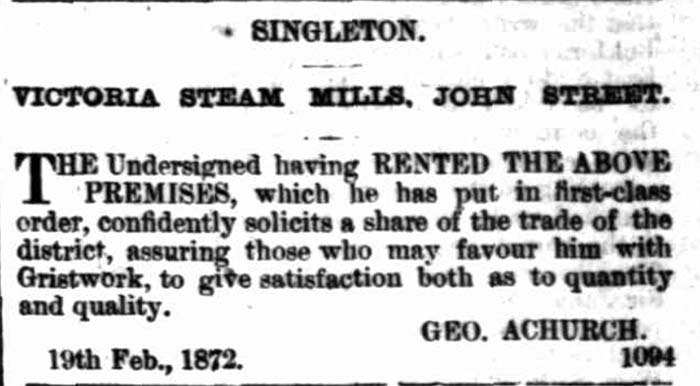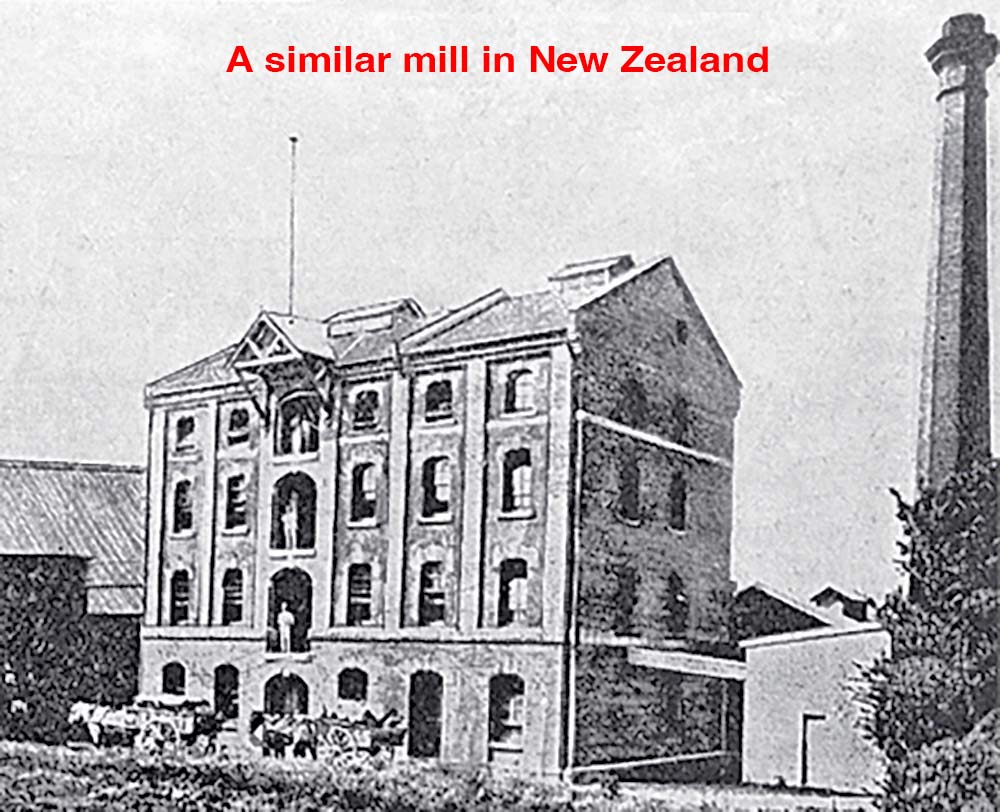
George Achurch --
and the Second Singleton Steam Mill in John Street
aka George Achurch's Mill, The Victoria Steam Mill, Baldwin's Mill
Singleton Mills homepage > Mills at Singleton > Achurch's steam mill at Singleton
George Achurch leased the second steam flour mill that had been established by Benjamin Singleton in John Street, Singleton.

The locations of eight mills built in Singleton township in the 1800s.
His lease lasted from 1872 to 1875 and during this period, the mill was called 'Achurch's Mill' or the 'Victoria Steam Mill'.
George Achurch's background
George Judkins Achurch (1807 – 1884) was born in Hertfordshire, UK, the son of a miller. He may have arrived in Sydney in 1851. [1]
George Achurch settled in Clarence Town, NSW, and operated a steam mill in the Williams River area for twenty years. [2]
Achurch's Mill in Clarence Town suffered serious damage during both the 1857 and the 1864 floods. [1] A report in 1864 stated:
| "...the chimney of Mr. Achurch's steam mill fell, completely crushing in its descent the boiler-shed, and depressing the boiler itself in its bed nearly a foot." [3] |
During his time as a miller in Clarence Town, George Achurch also met and overcame other difficulties, such as unfavourable seasons "aggravated by blight and rust in the wheat crops for a number of years". He was warmly farewelled by the townsmen, when he left Clarence Town in 1872 to move to Singleton. [4]
Leasing a mill established by the Singleton family
Benjamin Singleton and his family established their second steam flour mill in John Street, Singleton, in 1851 - 1853:
To read the full story of Benjamin Singleton's second Steam Flour Mill in John Street, including spectacular accounts of the boiler explosion and the stories of other mills established by the Singletons, download our free PDF: The Singleton Family Flour Mills at Singleton – |
Benjamin's son-in-law, Otto Baldwin, purchased this mill from Benjamin's widow, Mary Singleton, in 1861. [5]
At some stage, the milling machinery fell into disuse. Then in 1872, Otto Baldwin leased this mill to George Achurch:
"BALDWIN'S MILL – The mill in John-street, belonging to Mr. Otto Baldwin, which has not been used for milling purposes for some years, is about to be again put into working order, the premises having been leased by Mr. Achurch of Clarence Town, who expects to commence grinding wheat within a month, when we shall have three steam mills at work in Singleton." [6] |
The three steam flour mills operating in Singleton, mentioned at the end of the above quotation, would have been:
-- The Phoenix Mill,
-- Benjamin Singleton Junior's mill in George Street (operated by T. and E. B. Sawkins), and
-- this new milling operation by George Achurch.
By February 1872, George Achurch had opened this mill for business. He named this mill, the 'Victoria Steam Mills' (although it was usually called 'Achurch's Mill' in press reports):
"SINGLETON. VICTORIA STEAM MILLS, JOHN STREET. The undersigned having RENTED THE ABOVE PREMISES, which he has put in first-class order, confidently solicits a share of the trade of the district, assuring those who may favour him with Gristwork, to give satisfaction both as to quantity and quality. …GEO. ACHURCH." [7] |

Above: George Achurch's advertisement for his Victoria Steam Mills in Singleton, in The Maitland Mercury and Hunter River General Advertiser, 20 February 1872.
Interestingly, George Achurch had also used the grand name, 'Victoria Mills', for the mill he had run in Clarence Town in the 1850s. [8]
In 1873, George Achurch exhibited 100 pounds of bran in a local show and his exhibit was Highly Commended. [9]
Description of Achurch's Mill
Fact File on Achurch's Mill Our research found that Achurch's mill was located at about 172 John Street, Singleton, near the intersection with Hunter Street. The mill building was described as "very large". (No precise dimensions for this building have been located so far.) It was made of brick with four storeys and an attic (five floors). The steam engine was 14 horse power and it had four pairs of millstones. [10] |
In 1875, a description of Achurch's mill was published in The Singleton Argus and Upper Hunter General Advocate:
"ACHURCH'S MILL. This is a very large brick mill of four stories. It faces John-street. The engine is 14 horse-power, and the boiler, which is called a shell boiler, is [illegible] horse-power, and will contain 1200 gallons. There are four pair of stones, and wire and smutting machines. Three pair of stones are now in full operation, and there are five floors in the mill, which is in good working order. The engine has a very large fly-wheel. Mr Achurch came to Singleton three years ago and opened this mill, which had been closed for some time. Mr. Achurch conducted a mill on the Williams River for over 20 years." [10] |

Above: No photographs have yet been located of Achurch's Mill. However, from descriptions of this mill, it may have been similar in appearance to this steam mill in New Zealand. Source: Wikimedia Commons. Wood Bros. Flour Mill, Addington, Christchurch, NZ.
An abrupt end to Achurch's Mill in Singleton
In November 1875, following Otto Baldwin's death, his widow, Elizabeth Baldwin, put the mill occupied by George Achurch up for sale, along with three adjoining allotments in John Street, Singleton, where the mill stood. [11]
Then Elizabeth Baldwin, in January 1876, attempted to evict George Achurch from the John Street mill:
"EJECTMENT. –George Achurch was charged with refusing to give up possession of certain land in John-street, Singleton, upon which a flour mill is erected… The Bench declined to make an order." [12] |
William Kingston bought the land and the mill in May 1876. [13]
William Kingston (who would shortly open his new Railway Mill ) demolished the mill buildings. He advertised the three allotments for sale again in December 1877, as "the site of Singleton's Flour Mills, now removed". [14]
Thus ended the second steam flour mill that was established by the Singleton family in the town of Singleton.
Researched by Anne and Les Dollin
References
1. George Judkins Achurch (1807 – 1884), WikiTree, www.wikitree.com/wiki/Achurch-4, accessed 20 September 2023
2. The Singleton Argus and Upper Hunter General Advocate, 6 February 1875
3. Empire, 10 June 1864
4. The Maitland Mercury and Hunter River General Advertiser, 30 January 1872
5. NSW Lands Conveyance Document, Book 75, Number 675
6. The Maitland Mercury and Hunter River General Advertiser, 25 January 1872
7. The Maitland Mercury and Hunter River General Advertiser, 20 February 1872
8. The Maitland Mercury and Hunter River General Advertiser, 23 September 1856
9. The Maitland Mercury and Hunter River General Advertiser, 16 August 1873
10. The Singleton Argus and Upper Hunter General Advocate, 6 February 1875
11. The Maitland Mercury and Hunter River General Advertiser, 6 November 1875
12. The Maitland Mercury and Hunter River General Advertiser, 27 January 1876
13. NSW Lands Conveyance Document, Book 159, Number 638
14. The Maitland Mercury and Hunter River General Advertiser, 8 December 1877.
Further Reading
• Overview of Mills at Singleton • The Kurrajong Mills • The Wisemans Ferry Mills
